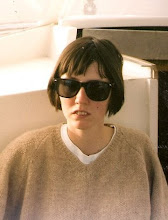The work was by Melbourne performance artist, Mira Oosterwegher whose work seems to use suspension of the body as a way of looking at control, power struggles and the way bodies sit and move in space. The gallery (Knight Street Art Space) has a large glass front and Mira Oosterwegher's body was visible suspended with an array of straps and cords from the outside of the space. A sign on the door instructed viewers to turn a lever upon entering, in order to raise or lower the performer's body.....kind of like some sort of medieval, mob-controlled torture device.
For much of the time the performer seemed poised but in discomfort. She lay with her hands behind her back, rearranged her hair and twitched and wriggled. The moments, when you could see her muscles buck and spasm and she swayed and rocked back and forth were fascinating. There's something interesting about seeing a body in this way- natural but not natural, presented for the viewer over a length of time, but entirely under the audiences' control. The performance lasted for around two (possibly three) hours.
One thing that I didn't like so much was that at certain points later in the performance Mira responded to people in the audience (who were evidently people known to her) asking if she wanted them to release her or lower her.
This really highlighted for me how important some degree of theatrical concentration and staging is to performance art. I think I prefer performances that have less interaction with audience members, and have that kind of awkward tension to them maintained. Intervention into a dangerous or risky performance should only really happen if the danger is truly life threatening, although I know that in a lot of great performances this intervention is essential and the main point of the work, say with Marina Abramovic or Chris Burden's work.
Here's how the work was described by the artist:
"Performing an action or repeating a gesture invites an examination, raising questions around subscribed meaning and the interactions between the embodied subject and cultural interpretations. Repetitive movement is both machine-like and the basis of learning and labour. A Bodily Negotiation explores this fraught balancing act: while we are the masters of our own bodies and their physicality, we are also unavoidably and powerfully acted on by the spaces we inhabit."
I've being checking out some of Mira Ooesterwegher's other work online.
This video in particular, of a work entitled The Weight of Nobody, is awesome.
